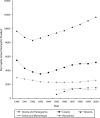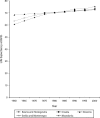The making and breaking of Yugoslavia and its impact on health
- PMID: 15514224
- PMCID: PMC1448556
- DOI: 10.2105/ajph.94.11.1894
The making and breaking of Yugoslavia and its impact on health
Abstract
The creation of nation-states in Europe has generally been assumed to be intrinsic to modernization and to be irreversible. The disintegration of Czechoslovakia, the Soviet Union, and Yugoslavia demonstrates that the process is not irreversible. I argue that in the case of Yugoslavia, (1) disintegration was caused by the interaction between domestic policies with regard to nationalities and integration into the global economy and (2) the impact of the disintegration of the federation on health care and public health systems has been profound. Improving and converging measures of mortality before the collapse gave way to increasing disparities afterward. The lesson is that processes of individual and social modernization do not result in improvements in health and well-being that are necessarily irreversible or shared equally.
Figures



Similar articles
-
On health politics. 1919.Am J Public Health. 2006 Aug;96(8):1382-5. doi: 10.2105/ajph.96.8.1382. Am J Public Health. 2006. PMID: 16864750 Free PMC article. No abstract available.
-
What Yugoslavia means: progress, nationalism, and health.Health Transit Rev. 1996;6 Suppl:253-72. Health Transit Rev. 1996. PMID: 10165306 Review.
-
[Croatian Medical Association, Andrija Stampar and public health politics in the Kingdom of Serbs, Croats and Slovenians (Kingdom of Yugoslavia)].Lijec Vjesn. 2005 May-Jun;127(5-6):151-7. Lijec Vjesn. 2005. PMID: 16281478 Croatian.
-
[Pioneers in the development of socio-medical ideas in Serbia].Srp Arh Celok Lek. 1981 Nov;109(11):1543-53. Srp Arh Celok Lek. 1981. PMID: 7051356 Serbian. No abstract available.
-
Social movements in health.Annu Rev Public Health. 2014;35:385-98. doi: 10.1146/annurev-publhealth-031912-114356. Epub 2013 Dec 11. Annu Rev Public Health. 2014. PMID: 24328986 Review.
Cited by
-
Association of the consumption of common food groups and beverages with mortality from cancer, ischaemic heart disease and diabetes mellitus in Serbia, 1991-2010: an ecological study.BMJ Open. 2016 Jan 5;6(1):e008742. doi: 10.1136/bmjopen-2015-008742. BMJ Open. 2016. PMID: 26733565 Free PMC article.
-
Gender disparities in mortality from infectious diseases in Serbia, 1991-2014: a time of civil wars and global crisis.Epidemiol Infect. 2016 Sep;144(12):2473-84. doi: 10.1017/S0950268816001345. Epidemiol Infect. 2016. PMID: 27483375 Free PMC article.
-
Boosting ICU capacity during the COVID-19 pandemic in the western Balkan region, The Republic of Srpska experience.J Public Health Res. 2023 Jan 25;12(1):22799036231151762. doi: 10.1177/22799036231151762. eCollection 2023 Jan. J Public Health Res. 2023. PMID: 36718459 Free PMC article.
-
Trends in suicide by hanging, strangulation, and suffocation in Serbia, 1991-2020: A joinpoint regression and age-period-cohort analysis.World J Psychiatry. 2022 Mar 19;12(3):505-520. doi: 10.5498/wjp.v12.i3.505. eCollection 2022 Mar 19. World J Psychiatry. 2022. PMID: 35433320 Free PMC article.
-
Overcoming challenges: implementing and scaling clinical pharmacy education and practice in the Republic of Srpska/Bosnia and Herzegovina.Int J Clin Pharm. 2025 May 26. doi: 10.1007/s11096-025-01939-7. Online ahead of print. Int J Clin Pharm. 2025. PMID: 40418436
References
-
- Brubaker R., Nationalism Reframed: Nationhood and the National Question in the New Europe (Cambridge: Cambridge University Press, 1996), 34.
-
- Ibid., 35.
-
- Carnegie Endowment for International Peace, The Other Balkan Wars: A 1913 Carnegie Endowment Inquiry in Retrospect With a New Introduction and Reflections on the Present Conflict (Washington, DC: Brookings Institution, 1993). See especially the Introduction by George F. Kennan. The report provides no data on the number of civilians killed, but it may have been larger than the number of soldiers killed. There is no way to be certain.
-
- Tomasevich J., Peasants, Politics, and Economic Change in Yugoslavia (Stanford, Calif: Stanford University Press, 1955), 216–217.
-
- Trouton R., Peasant Renaissance in Yugoslavia, 1900–1950 (London: Routledge and Kegan Paul Ltd, 1952); R. Bicanic, Economic Policy in Socialist Yugoslavia (Cambridge, England: Cambridge University Press, 1973); S. J. Kunitz, “Health Care and Workers’ Self-Management in Yugoslavia,” International Journal of Health Services 9 (1979): 521–537. - PubMed
Publication types
MeSH terms
LinkOut - more resources
Full Text Sources

